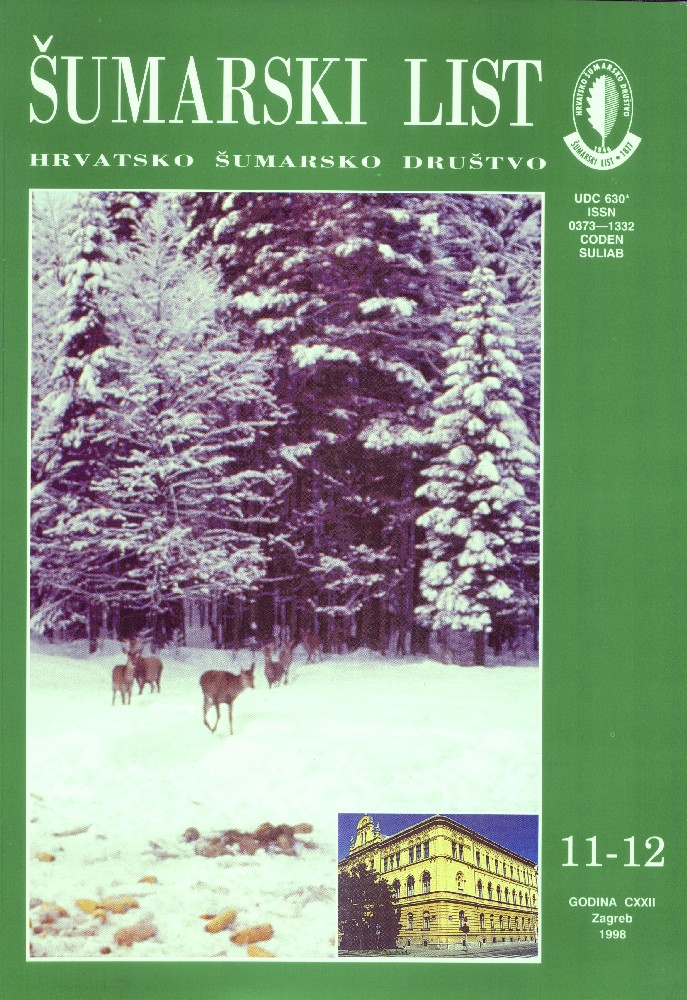
broj: 11-12/1998
pdf (21,9 MB) |
|
||||||||||||||
| IZVORNI ZNANSTVENI ČLANCI | ||
| Roša, J. | UDK 630* 165 + 168 + 48 (Quercus robur) 001. | |
| The Influence of Phosphogypsum From an Industrial Dump on the Pedunculate Oak (Quercus robur) pdf HR EN | 491 | |
| Summary: Decline and decay of pedunculate oak forests (Quercus robur L.) becomes a more and more important problem of forestry in Croatia. Decay of forests is obvious near industrial formations and their dumps. The effect of phosphogypsum and waste waters of fertiliser factories in Kutina on pedunculate oak forests which are located near these factories is examined in this elaboration.The chemical analysis of the water from the dumps has proved the presence of heavy metals (Al, Cd and others), as well as a remarkable low pH value of 1,2-2,6. The pedunculate oak growing in the surrounding of the dump showed 60-70% of the crown damage and therefore belongs to the category of highly damaged trees. As a first step in our investigation we applied a short-term cytotoxicity-test. Root-tip meristematic cells were treated by different dilution rates (from 0,5% to 10%) of phosphogypsum from the dump. Roots were excised from the sprouts germinated in laboratory from the acorns gathered in the tree seed stand. Mitotic activity decreased with an increase of concentration, except for the concentration of 2,5% where the opposite effect was noticed. All concentrations caused the same cytotoxic effect e. i. mitotic aberrations such as c-mitosis and lagging chromosomes appeared as a result of the spindle disturbances. The most frequent were subchromatide aberrations such as sticking of the chromosomes. There was no significant change of the mitotic activity after a 24-hour recovery for any of the concentrations. Mitotic activity remained low and even higher rate of the subchromatide aberrations were noticed. Allium-test was applied as a control test of the cyto- and genotoxicity of the phosphogypsum from the dumps. Bulbs of the onion Allium ascalonicum were germinated in the tap water and treated subsequently with the same dilutions of phosphogypsum that were used in cytotoxicity test with roots of pedunculate oak. As a negative control we used onions germinated in tap water while onions treated with maleichydrazide served as a positive control. Allium-test confirmed cyto- and genotoxicity of phospogypsum from the dumps. Important inhibition of the roots´ growth after a five-days-treatment with the all concentrations was noticed. Although mitotic activity was hardly lowered, a high number of the chromosomal aberrations was noticed of which chromosome breaks were the most frequent ones. The most frequent mitotic aberrations were c-mitosis and vagrant chromosomes. In order to establish the immediate influence ofphosphogypsum dumps on cytogenetic changes of pedunculate oak we analysed root-tip cells of the seedlings germinated from acorns which were collected from trees growing close to the dump. Seedlings germinated from acorns collected in the seedling stand served as negative control. No significant difference of the mitotic activity between the germs near the dump and germs from the seedling stand was noticed. On the other hand, the germs near the dump showed twice higher rate of aberrations. Two types of chromosome aberrations; sticking and anaphase bridges, and three types of mitotic aberrations; multipolar spindle, c-mitosis and vagrant chromosomes, were noticed Apart from the cytogenetic analyses of pedunculate oak, fluoride quantity in the leafs of the trees growing close to phosphogypsum dumps as well as trees from the seedling stand (control) was established. As increased quantity of fluoride in the leaves of the oaks near the dump was noticed, we analysed morphology of the epicuticular wax in leafs of the different development stages using an electrone-scanning microscope. The analysis revealed the connection between fluoride quantity in the leaves of pedunculate oak and the degree of epicuticular wax degradation. In other words, the early degradation (so called crust) of epicuticular wax on the stomata in the leaves of oaks close to the dump was recorded, while in the control leaves the same was not observed. Our research revealed the effect-complexity of the phosphogypsum dump on the vitality and the reproductive capacity of pedunculate oak. | ||
| PRETHODNO PRIOPĆENJE | ||
| Domac, J. | UDK 630* 238 : 620. 91 | |
| Present and Future Energy Production from Forestry Biomass pdf HR EN | 507 | |
| PREGLEDNI ČLANCI | ||
| Grubešić, M., Krapinec, K. | UDK 630* 151 + 152 | |
| Colonization of the Beaver (Castor fiber L. in the Sava Valley pdf HR EN | 515 | |
| STRUČNI ČLANCI | ||
| Zelić, J. | UDK 630* 181.1 + 182.1 + 22 | |
| Autochthonism and Further Cultivation of Sweet Chestnut (Castanea sativa Mill.) in Požega Mountains pdf HR EN | 525 | |
| Đuričić, I., Đuričić-Kuric, T. | UDK 630* 907.1 : 719 + 72.02 | |
| Wineyard Cottages on Southern Slopes of Mount Kalnik pdf HR EN | 537 | |


